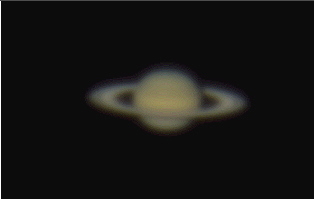
Imaging: Saturn, NGC6337 Planetary Nebula
Posted: 15 June 2012
Opened the observatory Thursday, 14 June, at 1922 MST, 93°F. The sky was clear and there was no breeze initially, although a strong breeze started blowing later in the night. At 1953 MST, viewed Mercury, 77X and 206X. A nearly "half-moon" phase was easily seen. At 1938 MST, viewed Saturn, 77X and 206X. A crisp view of the planet, ring, Cassini Division, and shadows was seen. No moons were visible, but at 1954 MST, four moons were visible: Titan, Dione, Tethys, and Rhea. Viewed Mars at 2004 MST, 206X and 364X. A strong gibbous phase was visible, as well as small polar caps and a large dark area. I then returned to Saturn and viewed at 364X, but seeing was not quite good enough for a nice view at this high power.
I then set up for eyepiece projection (160X) imaging with the D7000 DSLR. Focused on the star Spica using the Bahtinov Mask and did a test exposure. I captured this image, a stack of 954 HD video frames using Keith's Image Stacker, 1/30sec, ISO 3200:

Ended imaging at 2045 MST and began checking Observer Pro on the iPhone for possible DSO viewing and imaging targets. I selected NGC6337, a small faint planetary nebula in Scorpius. At 2118 MST, I viewed NGC6337, low in the southeast, 77X and 133X. It appeared star-like but was "fuzzy" when viewed with averted vision. At 2224 MST, I began preparations to image NGC6337. Did a focus test exposure on Antares with the Bahtinov Mask. I located a faint guide star and did a 5 minute, ISO 6400, guided exposure. This is the (cropped) result:

At 2256 MST, I attempted to image Pluto but as it turned out, the guide star I selected put Pluto just outside the frame field of view (FOV). Will try again on the next session. After I ended imaging, I attempted to locate Pluto visually using SkySafari 3 Pro on the iPhone to help identify stars in the eyepiece (77X and 133X) FOV. Unfortunately, I could not locate Pluto this night.
At 2339 MST, viewed M16, the Eagle Nebula, 77X.
Closed the observatory at 2350 MST, 75°F. No Kissing Bugs were seen this night.
Comments are welcome; use the Comments section below, or you can Email Me. Thanks.
Go to the previous report.
Return to the Cassiopeia Observatory Welcome Page.